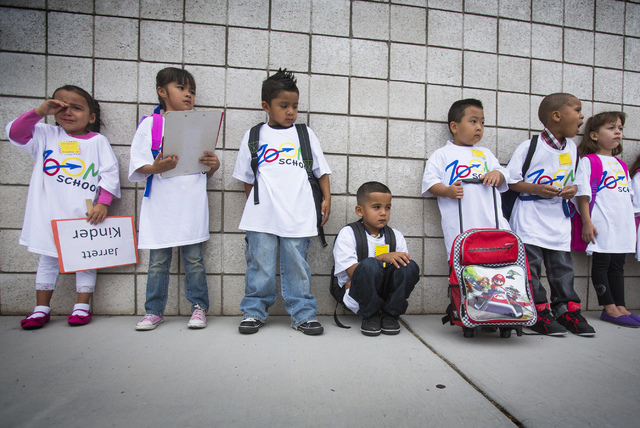Year-round schedules loom for crowded elementary schools

At three, the list of year-round Clark County elementary schools is short.
But that number may balloon to 68 year-round elementary schools in 2014-15, if officials follow the district’s regulations for relieving schools bursting at the seams with students.
While Clark County School District’s middle and high schools have 13,000 empty seats, the district’s elementary schools have 19,400 more students than their campuses were designed to accommodate, according to a head count on Aug. 28.
On average, Clark County’s 217 elementary schools are 14 percent over capacity, relying on portable classrooms, bathrooms and even lunchrooms to make ends meet.
Crowding at elementary schools is nothing new, but it’s building. Last year, elementary schools were, on average, 10 percent over capacity, and the School Board was considering a new elementary school consisting entirely of portables to ease the burden in the most crowded areas, such as the southwest Las Vegas Valley.
“We’re now out of portables,” School Board member Linda Young said at a Wednesday meeting where the board discussed options to alleviate crowded schools.
She noted that options are limited for helping the worst-off. At 53 elementary schools, they’re teaching at least a quarter more students than they were built to hold. Some schools, such as Wynn and Long elementary schools, are more than 70 percent over their capacities, relying on 18 and 16 portables, respectively.
“We’re in a quandary here, quite frankly,” Young said.
One option, although expensive, is making schools hold classes over 12 months instead of nine months. Students are spread out over five different tracks scheduled across 12 months. One track of students is always off, relieving the school of one-fifth of its enrollment.
The district has three triggers that must be met for the schedule shift to be considered. Enrollment must require eight portable classrooms this year and be expected to do the same next year. Student enrollment must exceed capacity by at least 25 percent for those two years. Lastly, the projected enrollment for next school year must represent a 5 percent increase over the average enrollment for the current school year and the preceding year.
Officials are watching 51 schools that are likely to meet all three of those requirements this school year, according to Rick Baldwin, the district’s director of demographics and zoning. But it’s ultimately up to Superintendent Pat Skorkowsky as to which schools make the switch.
Skorkowsky said he plans to also turn 14 additional schools year-round in 2014-15 though they may not have met the three triggers. These are the “zoom” schools receiving $39.4 million in state money specifically to improve the performance of English language learners concentrated at these campuses. The pressure is on for Skorkowsky who must show improvement to the Legislature.
But year-round schools aren’t cheap.
Each one costs taxpayers about $308,000 more to run each year. Changing 65 schools to year-round in 2014 would increase annual costs by $20 million.
The expense is why the cash-strapped district recently eliminated all 12-month schools after having 76 such schools up to 2009-10.
Board members couldn’t make up their minds Wednesday as to how crowding should be addressed. Year-round schools? Rezoning the attendance boundaries of all 217 elementary schools, which hasn’t been done in almost 20 years?
“I’m not sure we have a consensus on much,” said School Board President Carolyn Edwards after the board’s lengthy discussion.
Board member Deanna Wright said a district-wide rezone is “inevitable” if not this year, then next.
But with 14 percent more elementary students than seats, every school would still be over capacity no matter how effective the rezone, Edwards said.
“We’d just be moving a lot of families,” she said, adding “We know how to do year-round.”
Contact reporter Trevon Milliard at tmilliard@reviewjournal.com or 702-383-0279.